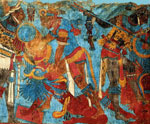|
MAJOR ARCHAEOLOGICAL SITES: PreClassic to PostClassic
CACAXTLA (circa A.D. 650-850)
Cacaxtla is located 50 miles southeast of México City. Writing at the end of the 16th century, the Tlaxcalan historian Diego Muñoz Camargo described Cacaxtla as the principal seat of the “Olmeca”, also known as the Olmeca Xicalanca. An archaeological survey of the region confirms that Cacaxtla was the most powerful capital in the Tlaxcalan region during the first half of what is known as the Texcalac cultural phase lasting from A.D. 650-1100. At this time Teotihuacán’s hegemony had been drastically eroded allowing small successor states like Cacaxtla to monopolize a vital exchange corridor that linked the Basin of México to the Gulf Coast and the Maya realms of the Usumacinta Basin.
 |
Cacaxtla was constructed as a remote citadel for an extended ruling family. The entire site covers approximately 180,000 square feet of which only the palace has been excavated. This residential core consists of a labyrinth of rooms, porticos, and passageways constructed around two main plazas oriented on a north-south axis. The architecture incorporated much of Teotihuacán’s talud-tablero style, together with a ground plan similar to Maya palaces like that at Palenque. Frescoes have been found throughout the site. The best preserved were recovered from the rooms adjoining the North Plaza, a six hundred square meter courtyard that was the focus of Cacaxtla’s ritual life. We know that Early Classic Maya lords emulated Teotihuacán’s architectural and artistic style as a means of displaying a special relationship with Mesoamerica’s most powerful state. Once Teotihuacán’s influence had eroded however, the reverse occurred. The Cacaxtla paintings show us that Central Mexican warlords could also incorporate Late Classic Maya style. Click on Image for more detail. |
 |
Cacaxtla’s Building B murals depict two factions of warriors engaged in ritual combat. The theme is clearly one of predator versus prey in which the executioners wear jaguar skin capes and their unarmed victims are dressed as quetzal birds and parrots. Click on Image for more detail. |
 |
The piers of the so-called Star Chamber feature a pair of blue anthropomorphic creatures. The male wears the arms and tail of a Scorpion signifying a constellation. According to later Aztec legends such beings were called Tzitzimime, spirits of defeated gods cast out of sky after they destroyed a sacred grove of fruit trees. Click on Image for more detail. |
Previous Page | Sites Index | Next Page
Table of Contents
Return to top of page |




